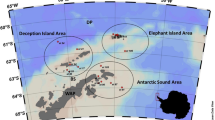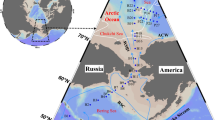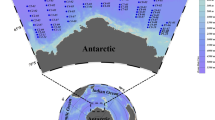Abstract
There were different biogeographical tintinnids in the oceans. Knowledge of their distribution pattern and mixing was important to the understanding of ecosystem functions. Yellow Sea (YS) and Bohai Sea (BS) were semi-enclosed seas influenced by warm water intrusion and YS cold bottom water. The occurrence of tintinnids in YS and BS during two cruises (summer and winter) were investigated to find out: i) whether warm-water tintinnids appeared in YS and BS; ii) whether boreal tintinnids appeared in high summer; iii) the core area of neritic tintinnids and iv) how these different biogeographical tintinnids mixed. Our results showed that tintinnid community was dominated by neritic tintinnid. We confirmed the occurrence of warm-water tintinnids in summer and winter. In summer, they intruded into BS and mainly distributed in the upper 20 m where Yellow Sea Surface Warm Water (YSSWW) developed. In winter, they were limited in the surface water of central deep region (bottom depth >50 m) of YS where were affected by Yellow Sea Warm Water (YSWW). Boreal tintinnids occurred in YS in high summer (August) and in winter, while they were not observed in BS. In summer, the highest abundance of boreal tintinnids occurred in Yellow Sea Bottom Cold Water, indicating the presence of an oversummering stock. In winter, they were concentrated in the north of YSWW. Vertically, neritic tintinnids abundance was high in the bottom layers. Horizontally, high neritic tintinnids abundance in bottom layers occurred along the 50 m isobath coinciding with the position of front systems. Front systems were the core distribution area of neritic tintinnids. High abundance areas of warm-water and boreal tintinnids were clearly separated vertically in summer, and horizontally in winter. High abundance of neritic tintinnids rarely overlapped with that of warm-water or boreal tintinnids.
Similar content being viewed by others
References
Acha, E. M., Mianzan, H. W., Guerrero, R. A., Favero, M., and Bava, J., 2004. Marine fronts at the continental shelves of austral South America: Physical and ecological processes. Journal of Marine Systems, 44 (1-2): 83–105.
Belkin, I., and Cornillon, P., 2003. SST fronts of the Pacific coastal and marginal seas. Pacific Oceanography, 1 (2): 90–113.
Chen, C. T. A., 2009. Chemical and physical fronts in the Bohai, Yellow and East China seas. Journal of Marine Systems, 78 (3): 394–410.
Dolan, J. R., 2017. Historical trends in the species inventory of tintinnids (ciliates of the microzooplankton) in the Bay of Villefranche (NW Mediterranean Sea): Shifting baselines. European Journal of Protistology, 57: 16–25.
Dolan, J. R., Montagnes, D. J., Agatha, S., Coats, D. W., and Stoecker, D. K., 2012. The Biology and Ecology of Tintinnid Ciliates: Models for Marine Plankton. John Wiley & Sons, Chichester, 1–296.
Dolan, J. R., Ritchie, M. E., and Ras, J., 2007. The ‘neutral’ community structure of planktonic herbivores, tintinnid ciliates of the microzooplankton, across the SE Tropical Pacific Ocean. Biogeosciences, 4 (3): 297–310.
Gómez, F., 2007. Trends on the distribution of ciliates in the open Pacific Ocean. Acta Oecologica, 32 (2): 188–202.
Hickox, R., Belkin, I., Cornillon, P., and Shan, Z., 2000. Climatology and seasonal variability of ocean fronts in the East China, Yellow and Bohai seas from satellite SST data. Geophysical Research Letters, 27 (18): 2945–2948.
Hsueh, Y., 1988. Recent current observations in the eastern Yellow Sea. Journal of Geophysical Research-Oceans, 93 (C6): 612–625.
Kato, S., and Taniguchi, A., 1993. Tintinnid ciliates as indicator species of different water masses in the western North Pacific Polar Front. Fisheries Oceanography, 2 (3-4): 166–174.
Kim, Y. O., Shin, K., Jang, P. G., Choi, H. W., Noh, J. H., Yang, E. J., Kim, E., and Jeon, D., 2012. Tintinnid species as biological indicators for monitoring intrusion of the warm oceanic waters into korean coastal waters. Ocean Science Journal, 47 (3): 161–172.
Kofoid, C. A., 1929. A Conspectus of the Marine and Freshwater Ciliata Belonging to the Suborder Tintinnoinea, with Descriptions of New Species, Principally from the Agassiz Expedition to the Eastern Tropical Pacific, 1904–1905. University of California Press, California, 403pp.
Kofoid, C. A., and Campbell, A. S., 1939. The Ciliata: The Tintinnoinea. Reports on the Scientific Results of the Expedition to the Eastern Tropical Pacific, 1904–1905. Museum of Comparative Zoology at Harvard College, Cambridge, 474pp.
Le Fèvre, J., 1986. Aspects of the biology of frontal systems. Advances in Marine Biology, 23: 163–299.
Li, H. B., Xiao, T., Ding, T., and Lv, R. H., 2006. The distribution of bacterioplankton in the Yellow Sea Cold Water Mass (YSCWM). Acta Ecologica Sinica, 26 (4): 1012–1020 (in Chinese with English abstract).
Li, H. B., Xu, Z. Q., Zhang, W. C., Wang, S. Q., Zhang, G. T., and Xiao, T., 2016a. Boreal tintinnid assemblage in the northwest Pacific and its connection with the Japan Sea in summer 2014. PLoS One, 11 (4): e0153379.
Li, H. B., Zhang, W. C., Yu, Y., Feng, M. S., and Xiao, T., 2014. Tintinnid community in surface waters along a transect in Yellow Sea and East China Sea in winter. Marine Sciences, 38 (8): 1–7.
Li, H. B., Zhao, Y., Chen, X., Zhang, W. C., Xu, J. H., Li, J., and Xiao, T., 2016b. Interaction between neritic and warm water tintinnids in surface waters of East China Sea. Deep-Sea Research Part II–Topical Studies in Oceanography, 124: 84–92.
Modigh, M., Castaldo, S., Saggiomo, M., and Santarpia, I., 2003. Distribution of tintinnid species from 42°N to 43°S through the Indian Ocean. Hydrobiologia, 503 (1-3): 251–262.
Pierce, R. W., and Turner, J. T., 1993. Global biogeography of marine tintinnids. Marine Ecology Progress Series, 94 (1): 11–26.
Pierrot-Bults, A. C., and Angel, M. V., 2012. Pelagic biodiversity and biogeography of the oceans. Biology International, 59: 9–35.
Riou, V., Fonseca-Batista, D., Roukaerts, A., Biegala, I. C., Prakya, S. R., Loureiro, C. M., Santos, M., Muniz-Piniella, A. E., Schmiing, M., Elskens, M., Brion, N., Martins, M. A., and Dehairs, F., 2016. Importance of N2-fixation on the productivity at the North-Western Azores Current/Front System, and the abundance of diazotrophic unicellular cyanobacteria. PLoS One, 11 (3): e0150827. DOI: 10.1371/journal.pone.015 0827.
Santoferrara, L., and Alder, V., 2009. Abundance trends and ecology of planktonic ciliates of the south-western Atlantic (35°63S): A comparison between neritic and oceanic environments. Journal of Plankton Research, 31 (8): 837–851.
Spinelli, M., Guerrero, R., Pajaro, M., and Capitanio, F., 2013. Distribution of Oikopleura dioica (Tunicata, Appendicularia) associated with a coastal frontal system (39°–41°S) of the SW Atlantic Ocean in the spawning area of Engraulis anchoita anchovy. Brazilian Journal of Oceanography, 61 (2): 141–148.
Taniguchi, A., 1984. Microzooplankton biomass in the arctic and subarctic Pacific Ocean in summer. Memoirs of National Institute of Polar Research. Special Issue, 32: 63–80.
Taylor, A. G., Goericke, R., Landry, M. R., Selph, K. E., Wick, D. A., and Roadman, M. J., 2012. Sharp gradients in phytoplankton community structure across a frontal zone in the California Current Ecosystem. Journal of Plankton Research, 34 (9): 778–789.
Teague, W. J., and Jacobs, G. A., 2000. Current observations on the development of the Yellow Sea Warm Current. Journal of Geophysical Research-Oceans, 105 (C2): 3401–3411.
Utermöhl, H., 1958. Zur vervollkommnung der quantitativen phytoplankton-methodik. Mitteilung Internationale Vereinigung fuer Theoretische unde Amgewandte Limnologie, 9: 1–38.
Wang, C., 1936. Notes on Tintinnoinea from the gulf of Pe-Hai. Sinensia, 7: 353–370.
Wang, L., Li, C., and Yu, F., 2013. Zooplankton community structure in the south Yellow Sea in winter and indication of the Yellow Sea Warm Current. Oceanologia et Limnologia Sinica, 44: 853–859 (in Chinese with English abstract).
Wang, R., and Zuo, T., 2004. The Yellow Sea Warm Current and the Yellow Sea Cold Bottom Water, their impact on the distribution of zooplankton in the southern Yellow Sea. Journal-Korean Society of Oceanography, 39 (1): 1–13.
Wang, R., Zuo, T., and Wang, K., 2003. The Yellow Sea Cold Bottom Water Anoversummering site for Calanus sinicus (Copepoda, Crustacea). Journal of Plankton Research, 25 (2): 169–183.
Yu, F., Zhang, Z. X., Diao, X. Y., and Guo, J. S., 2010. Observational evidence of the Yellow Sea Warm Current. Chinese Journal of Oceanology and Limnology, 28 (3): 677–683.
Yu, Y., Zhang, W. C., Feng, M. P., Zhao, Y., Zhang, C. X., Zhou, F., and Xiao, T., 2016. Differences in the vertical distribution and response to freshwater discharge between aloricate ciliates and tintinnids in the East China Sea. Journal of Marine Systems, 154: 103–109.
Yu, Y., Zhang, W. C., Wang, S. W., and Xiao, T., 2013. Abundance and biomass of planktonic ciliates in the sea area around Zhangzi Island, northern Yellow Sea. Acta Ecologica Sinica, 33 (1): 45–51.
Yu, Y., Zhang, W. C., Zhang, C. X., Zhou, F., Zhao, N., and Xiao, T., 2014. Basin-scale variation in planktonic ciliate distribution: A detailed temporal and spatial study of the Yellow Sea. Marine Biology Research, 10 (7): 641–654.
Zhang, C. X., Zhang, W. C., Xiao, T., Lu, R. H., Sun, S., and Song, W. B., 2009. Wintertime meso-scale horizontal distribution of large tintinnids in the southern Yellow Sea. Chinese Journal of Oceanology and Limnology, 27 (1): 31–37.
Zhang, C. X., Zhang, W. C., Xiao, T., Lue, R. H., Sun, S., and Song, W. B., 2008. Meso-scale spatial distribution of large tintinnids in early summer in southern Yellow Sea. Chinese Journal of Oceanology and Limnology, 26 (1): 81–90.
Zhang, S., Chen, X., Zhang, W. C., Zhang, F., and Xiao, T., 2018. Differences in planktonic ciliate spatial distribution in spring and autumn in the southern Yellow Sea. Acta Oceanologica Sinica, DOI: 10.1007/s13131-018-1147-y.
Zhang, W. C., and Wang, R., 2000a. Rapid changes in stocks of ciliate microzooplankton associated with a hurricane in the Bohai Sea (China). Aquatic Microbial Ecology, 23 (1): 97–101.
Zhang, W. C., and Wang, R., 2000b. Summertime ciliate and copepod nauplii distributions and micro-zooplankton herbivorous activity in the Laizhou Bay, Bohai Sea, China. Estuarine Coastal and Shelf Science, 51 (1): 103–114.
Zhang, W. C., Feng, M. P., Yu, Y., Zhang, C. X., and Xiao, T., 2012. An Illustrated Guide to Contemporary Tintinnids in the World. Science Press, Beijing, 1–499.
Zhang, W. C., Xu, K. D., Wan, R. J., Zhang, G. T., Meng, T. X., Xiao, T., Wang, R., Sun, S., and Choi, J. K., 2002. Spatial distribution of ciliates, copepod nauplii and eggs, Engraulis japonicus post-larvae and microzooplankton herbivorous activity in the Yellow Sea, China. Aquatic Microbial Ecology, 27 (3): 249–259.
Zhu, Z. S., Lin, S. Q., Huang, L. F., and Guo, F., 2009. Preliminary study on bacterivory of heterotrophic nanoflagellate upon heterotrophic bacteria and cyanobacteria in the Huanghai Sea Cold Water Mass area. Acta Oceanologica Sinica, 31 (5): 123–131 (in Chinese with English abstract).
Acknowledgements
This work was supported by the National Natural Science Foundation of China (No. 41576164), the ‘Strategic Priority Research Program-Western Pacific Ocean System: Structure, Dynamics and Consequences’ of the Chinese Academy of Sciences (No. XDA11020103.1), and NSFC-Shandong Joint Fund for Marine Ecology and Environmental Sciences (No. U1606404). The authors thank the captain and crews of R/V Dongfanghong-2, Chen Liang, Zhaojie Teng, Cong Xu, and Shan Zhang for their assistance in the field and laboratory work.
Author information
Authors and Affiliations
Corresponding author
Rights and permissions
About this article
Cite this article
Chen, X., Li, H., Zhao, Y. et al. Distribution of Different Biogeographical Tintinnids in Yellow Sea and Bohai Sea. J. Ocean Univ. China 17, 371–384 (2018). https://doi.org/10.1007/s11802-018-3482-1
Received:
Revised:
Accepted:
Published:
Issue Date:
DOI: https://doi.org/10.1007/s11802-018-3482-1




